Russian President Vladimir Putin, Crimean leaders and the mayor of Sevastopol signed a treaty on the accession of the Republic of Crimea and the city of Sevastopol to Russia on March 18, 2014. Sputnik presents to you a photo gallery dedicated to the history of Crimea — from being a part of ancient Greece to the modern times.

The creation of the first independent state on the shores of Crimea dates back to the first half of the 5th century BC as the democratic Republic of Chersonesus, part of modern city of Sevastopol, emerged. Prince Vladimir was baptized there and then he converted all of Russia to Christianity.
Above: A section of the Chersonesus Tavrichesky National Reserve, including the ruins of the ancient city of Chersonesus.
Above: A section of the Chersonesus Tavrichesky National Reserve, including the ruins of the ancient city of Chersonesus.
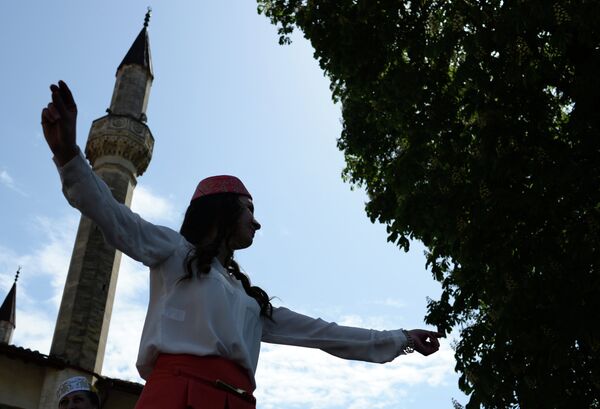
The territories of Crimea were under the control of a Turkic vassal state of the Ottoman Empire, Crimean Khahanate, for almost 300 years from 1478 to 1774.
Above: A young woman dances in front of the Grand Khan Mosque at the Bakhchisarai Historical Cultural Reserve in the southern Crimea.
Above: A young woman dances in front of the Grand Khan Mosque at the Bakhchisarai Historical Cultural Reserve in the southern Crimea.

On April 8, 1783, under the rule of Catherine the Great, Crimea became part of Russia.
Above: Lithography by unknown artist "Empress Catherine the Second".
Above: Lithography by unknown artist "Empress Catherine the Second".

The Crimean War began with a naval battle of Sinop in 1853 and ended in 1856. The Russian squadron under the command of Vice Admiral Nakhimov defeated a superior Turkish squadron and assured the domination of the Russian fleet in the Black Sea.
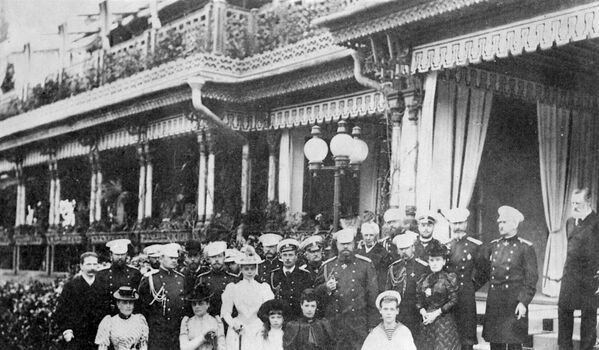
Beginning with Emperor Nicholas I and ending with the Emperor Nicholas II, Yalta actually was the third capital of the Russian Empire and it was a center of international activity annually from spring to late autumn.
Above: Members of the imperial family Romanov in front of the palace in Livadia, 1894.
Above: Members of the imperial family Romanov in front of the palace in Livadia, 1894.

In Livadia, in 1898, Nicholas II worked on the Russian proposal of the reduction and limitation of armaments and the creation of an international court to prevent military conflicts between the states. These offers then became the basis of the Hague Peace Conference in 1899.
Above: Emperor Nicholas II stands leaning against a straw armchair in Livadia.
Above: Emperor Nicholas II stands leaning against a straw armchair in Livadia.
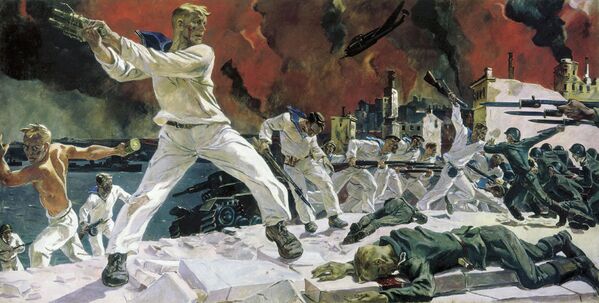
The Siege of the city of Sevastopol during WWII (1941-1942) by the Axis powers of Germany, Romania, and Italy was one of the most tragic pages in the history of the Great Patriotic War.
Above: The Siege of Sevastopol by Soviet Russian painter Aleksandr Deyneka.
Above: The Siege of Sevastopol by Soviet Russian painter Aleksandr Deyneka.
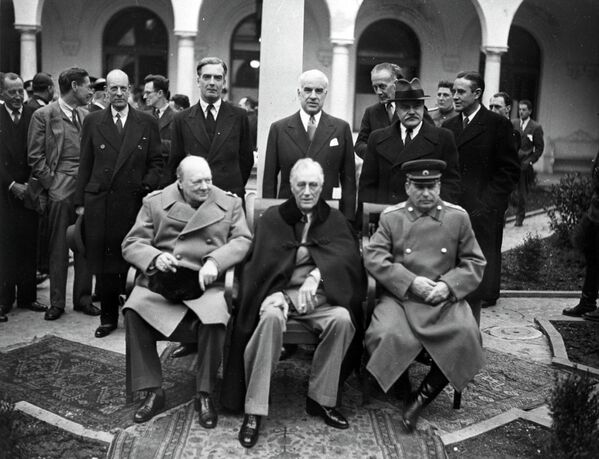
The Yalta Conference of the Allied Forces (4 -11 February 1945) in the Livadia Palace in Yalta was the second meeting of the leaders of the allies, the USSR, the US and Great Britain, during WWII. It was dedicated to the establishment of the post-war world order.
Above: The Yalta Conference of Allied leaders. First row, sitting: British Prime Minister Churchill, US President Roosevelt and USSR leader Stalin before a meeting. Standing: British Foreign Minister Eden, US Secretary of State Stettinius and USSR foreign policy chief Molotov.
Above: The Yalta Conference of Allied leaders. First row, sitting: British Prime Minister Churchill, US President Roosevelt and USSR leader Stalin before a meeting. Standing: British Foreign Minister Eden, US Secretary of State Stettinius and USSR foreign policy chief Molotov.

The controversial transfer of Crimea to Ukraine was adopted by Soviet leader Nikita Khrustchev in 1954. Experts still discuss the legitimacy of the procedure.
Above: Nikita Khrushchev (center) and Iosip Broz Tito (standing with his back) eyeing a hunting trophyю in Crimea.
Above: Nikita Khrushchev (center) and Iosip Broz Tito (standing with his back) eyeing a hunting trophyю in Crimea.
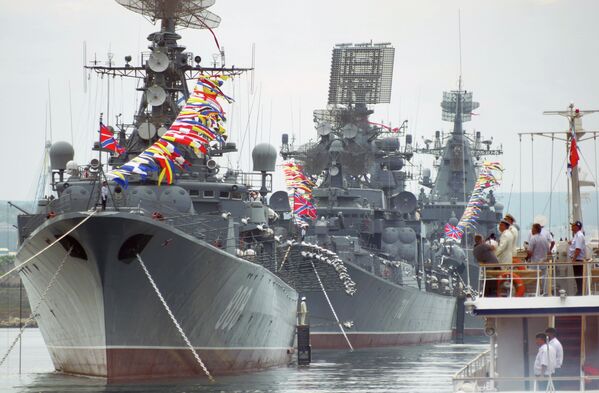
In 1997, Russia and Ukraine signed a Partition Treaty determining the fate of the military bases and warships in Crimea. The deal allowed the Russian Black Sea Fleet to stay in Crimea until 2017. It was extended by another 25 years to 2042 with a 5-year extension option in 2010.
Above: A boat carrying Black Sea Fleet Commander-in-Chief, Admiral Alexander Vitko, right, during the Navy Day parade rehearsal in Sevastopol.
Above: A boat carrying Black Sea Fleet Commander-in-Chief, Admiral Alexander Vitko, right, during the Navy Day parade rehearsal in Sevastopol.

On March 2014, a referendum on Crimea's status was held, with more than 90 percent of voters supporting the republic's reunification with Russia.
Above: A Crimean couple kissing as people celebrate in Simferopol's Lenin Square after exit polls showed that about 93 percent of voters in Crimea region supported reunification with Russia on March 16, 2014.
Above: A Crimean couple kissing as people celebrate in Simferopol's Lenin Square after exit polls showed that about 93 percent of voters in Crimea region supported reunification with Russia on March 16, 2014.
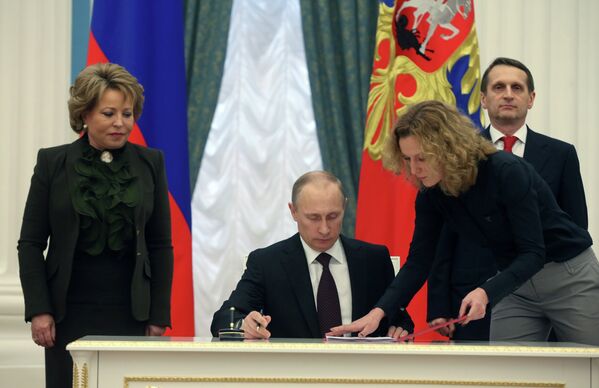
12/13
© AP Photo / Sergei Chirikov, Pool
On March 21, Vladimir Putin signed a law to ratify the treaty on the accession of Crimea and the city of Sevastopol to Russia, and a federal constitutional law for the procedure of their incorporation into Russia.
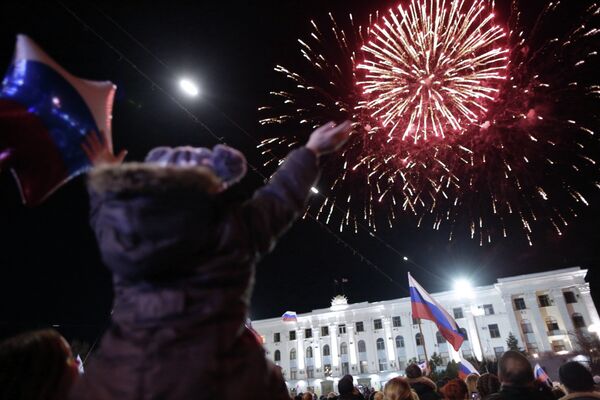
Above: People watch fireworks during a concert dedicated to the one-year anniversary of Russia-Crimea reunification in Simferopol on March 16, 2015.



